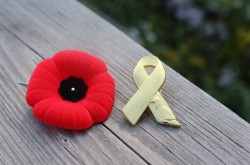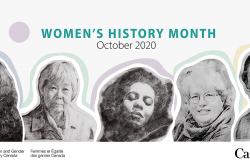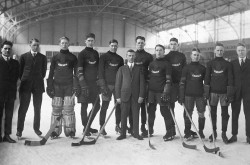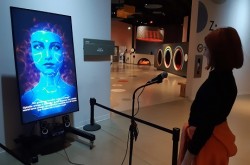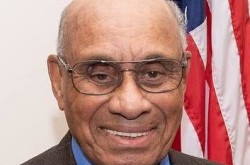Honouring an innovator who gave others the “gift of freedom”
Ottawa resident Elaine Wolfe was undoubtedly thinking about her late father, Clifford Wolfe, as she visited the Moving Stories exhibition at the Canada Science and Technology Museum last week.
The temporary exhibition – which showcases some rarely-seen artifacts from the museum’s transportation collection – includes Elaine’s 1988 Chevy Blazer, outfitted with an innovative wheelchair lift that was invented by her dad when she was a young adult.
“Calling my first truck an artifact is making me feel very old,” jokes Elaine, who visited the opening of the exhibition with a large group of friends and family, including her mother and her two grown daughters.
Back in 1983, 18-year-old Elaine dove into the shallow end of the swimming pool and broke her neck. A quadriplegic due to the accident, she underwent nearly a year of intense physiotherapy and occupational therapy at the Ottawa Rehabilitation Centre.
“It was quite a shock,” recalls Elaine of the accident. “It’s tough to wrap your head around – when you first wake up and you can’t move.”
But the strong-spirited teen was dedicated to strengthening her body, and credits the rehabilitation team, family, and friends for her incredible progress.
“When I initially broke my neck, I could only shrug my shoulders; but I was very lucky it was an incomplete fracture,” she explains. “Building my strength as the muscles came back was my main focus; now I can actually move my arms.”
Prior to the accident, Elaine had been planning to attend university in Waterloo, Ontario. Like most kids her age, she recalls being excited to get away from her parents.
“During those months, I really started looking at options for university and transportation,” she says, adding that she ultimately decided to attend Carleton University as it offered the best wheelchair accessibility at the time – including a wheelchair-accessible residence. “There wasn’t a moment that I didn’t consider ways in which I could be independent.”
In 1984, the determined teen moved from Smiths Falls to Ottawa, and began studying Mass Communications at Carleton University. Although she had learned to drive before the accident – her dad had taught her and her sisters with his old Volkswagon “bug” – she now had to rely on public transit to get around in her wheelchair.
Finding a better way
After university, she began working. She recounts the many extra hours it took her to get to and from her workplace – which made for long, tiring days. Elaine remembers talking to her dad about the transit system’s inconsistent and time-consuming service.
“It was my complaining about what was available to me that triggered him to say, ‘Hey, I think I can figure something out,’” says Elaine. “I was looking into options of what I could drive and at that time, there were only full-sized vans available. They had raised roofs, they were ugly and bulky. There was just no alternative, and I really wanted something sporty!”
Eager to help his daughter, Clifford Wolfe set about sketching how a vehicle might be modified for easy access by wheelchair.
“My dad was just a problem solver,” says Elaine. “He was very proud of my independence and he wanted to encourage it in every way possible.”
Elaine and her father brainstormed what type of vehicle would be best for her. She explains they ultimately picked the Chevy Blazer because it was sporty, and it had four-wheel drive.
“In Canada, you can’t get stuck in the winter,” says Elaine. “Being disabled, I wouldn’t be able to get out and go anywhere in the snow – I know of people who have actually died that way. My dad thought of safety above everything else.”

Elaine demonstrates how the Elaine Anne Lift System works, shortly after it was created.
After Elaine purchased the vehicle, Clifford installed a prototype of his invention – later patented as the Elaine Anne Lift System. By holding a magnet to the rear taillight of the vehicle, Elaine could activate the driver’s door to open and the lift to descend to ground level. She could then wheel herself onto the lift, which would bring her up to the driver’s position – all while sitting in her wheelchair. Inside, the Blazer was equipped with a modified steering wheel – which Elaine could operate with her right arm – and a hand-activated gas and brake for her left hand.
Elaine recalls her first time driving the modified Blazer as “absolutely terrifying.”
“I was worried I wasn’t strong enough to turn the wheel, or to remember to push for the brake and pull for the gas,” she says. But her dad patiently worked with her until she felt comfortable. “He took me out to an old rock quarry and we practised for weeks; he was diligent in making me learn how to drive. It was stressful, but exceptionally fun.”
Looking back, Elaine reflects on the enormous impact her father’s innovation had on her life.
“He gave me the gift of freedom,” she says simply. “I just absolutely loved having the truck; it gave me more independence than I’d had in the whole five years since I’d become paralyzed. Feeling that free, I engaged in way more activities and I think I had a more fulfilling life than I would have, because I would have been less inclined to do things if it was more difficult.”
The ripple effect
Almost immediately, the Elaine Anne Lift System garnered a lot of attention.
“Almost every disabled person approached me and asked me where I got the lift,” says Elaine, adding that in 1989, her dad made a second lift for one of her close friends, Mike Griffin.
Clifford and his wife, Elizabeth, realized they had a tremendous business opportunity. They formed a company and bought a shop – with Elizabeth running the office.
“It was a team effort with mom and dad, they really worked well together,” recalls Elaine.
More than 100 Elaine Anne Lift Systems were produced.
“Trucks were sent to Belgium, Austria, Israel, Canada and the U.S.,” says Elaine. “The customers were all quadriplegics who never thought they could pursue their dreams – and they were so grateful for my dad and his technology.”

Elaine carried young Jamie in a sling while getting her in and out of the vehicle.
A modified motherhood
Years later, when Elaine and her husband, Jim were ready to start a family, Clifford once again began brainstorming ways to make motherhood more accessible for his daughter.
“He was just really the kind of person that started thinking of solutions if you presented a problem,” says Elaine. “When I became pregnant, we started talking about how I could possibly travel independently with a baby.”

Clifford Wolfe bolted a t-frame bar next to the driver’s seat, so Elaine could get baby Jamie in and out of the vehicle herself.
Clifford’s solution was to mount a carseat in the console of the Chevy Blazer, which would allow his daughter to reach her baby.
“With safety in mind, he manufactured a t-frame bar and bolted it to the frame of the truck, then he secured the car seat to that,” says Elaine, adding that the t-frame is still visible in the Blazer, which is now on display as part of the museum’s exhibition.
Clifford also ensured the car seat’s mechanism was accessible for Elaine.
“I wasn’t strong enough to push that little button in the middle to release the seatbelt, so he just manufactured a lever and bolted it on,” she says. “So all I had to do was push on the lever and easily take the seatbelt off.”
Elaine has two daughters, who both used the modified car seat until around age three. At that point, they were big enough to climb in themselves, says Elaine.

Elaine’s daughter, Jamie, with her modified playpen in the background.
But Clifford’s inventions didn’t end with the Blazer. He also modified a desk, to make a baby change table that Elaine could roll under with her wheelchair. Next, he turned his attention to making an accessible playpen.
“He bought a regular playpen and put it up on table legs,” says Elaine. He had a seamstress put zippers in the sides of it, so I would just wheel up and unzip it and put the baby in.”
Elaine credits her father for allowing her to fully embrace motherhood.
“I always thought that my husband would be the primary caregiver – and I would continue working. The things my dad did helped allow me to be the primary caregiver of the kids.”
Elaine says she only wishes that her father could have been with the family as they toured the Moving Stories exhibition. In 2008, Clifford was diagnosed with cancer; he passed away in 2009.
Elaine’s sister, Karen Wolfe, helped her parents with the business when their dad was still alive. After his passing, Karen formed her own company, Wolfe Mobility, based in Picton, Ontario.
“She has a very successful business, distributing products for the disabled,” says Elaine of her sibling. While the Elaine Anne Lift System is not part of the current product offering, she hopes to produce it someday.
“I think Karen started her business because she saw how happy it made Dad to help people and change their lives; he really enjoyed that part of it so much.”





























